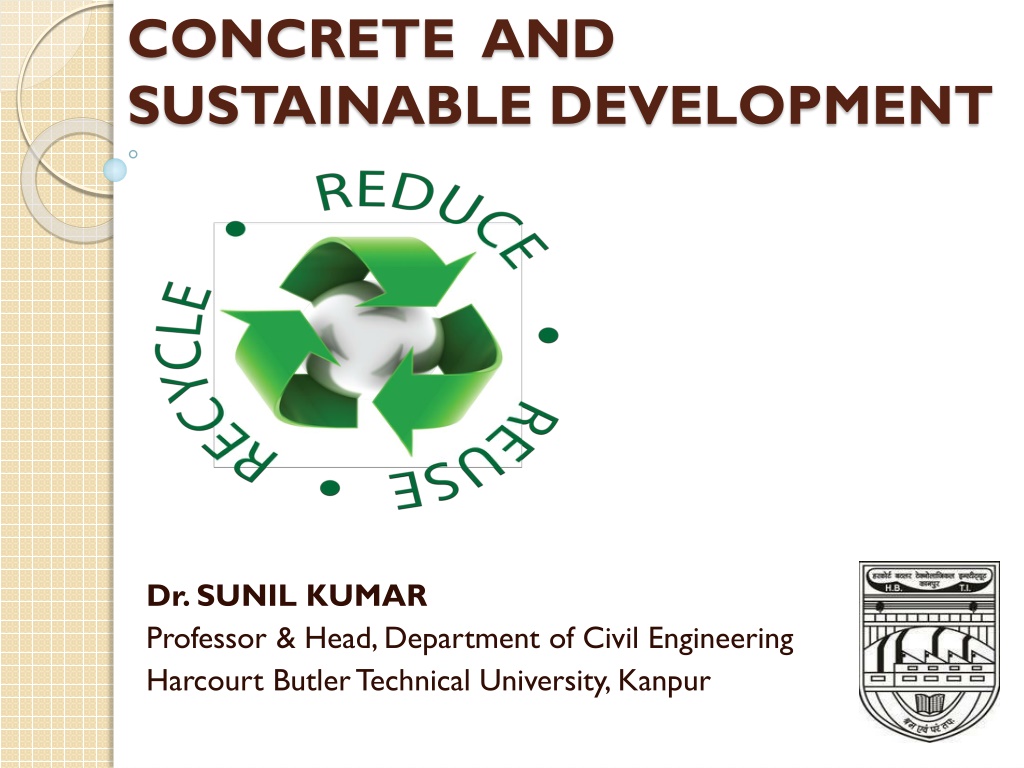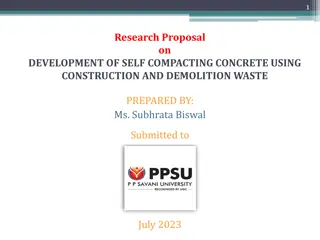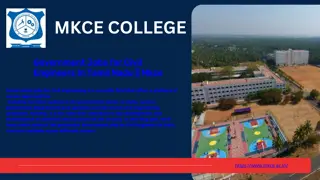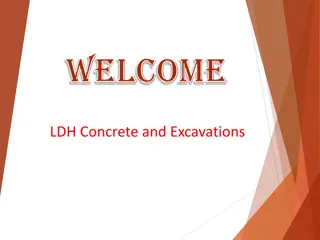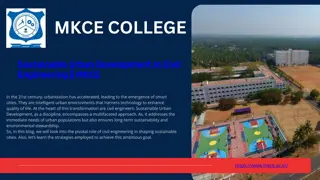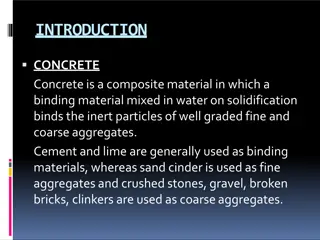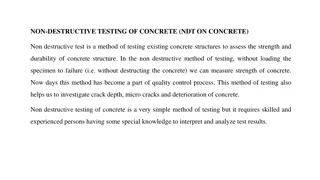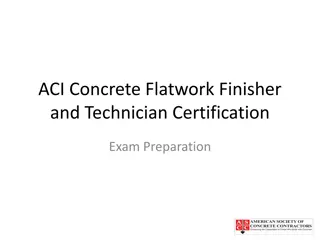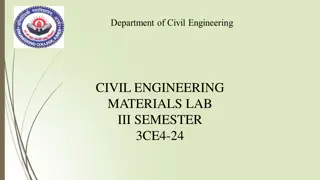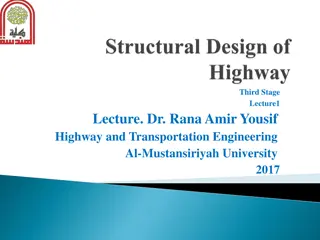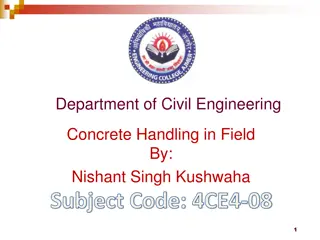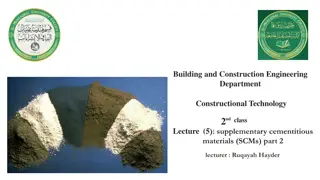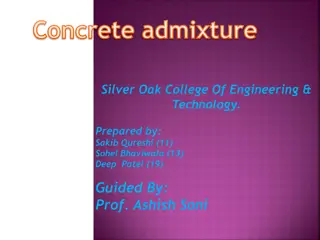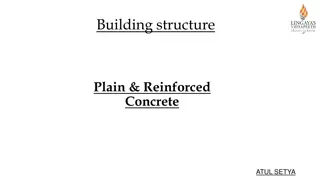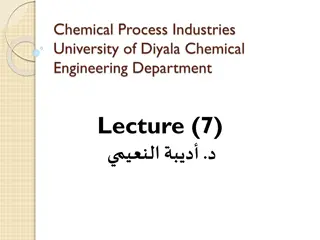Concrete and Sustainable Development in Civil Engineering by Dr. Sunil Kumar
Dr. Sunil Kumar from Harcourt Butler Technical University, Kanpur, discusses concrete as a conglomerate rock with large aggregate particles in a paste matrix. Sustainable development involves remedying past mistakes, avoiding pollution, and balancing development with environmental preservation. The concrete industry plays a crucial role in reducing greenhouse gas emissions. Key ingredients of concrete include cement, aggregates, water, and admixtures. Expectations from good concrete cover aspects from fresh state to hardened state. Recycling of construction and demolition debris is important for environmental sustainability.
Download Presentation

Please find below an Image/Link to download the presentation.
The content on the website is provided AS IS for your information and personal use only. It may not be sold, licensed, or shared on other websites without obtaining consent from the author. Download presentation by click this link. If you encounter any issues during the download, it is possible that the publisher has removed the file from their server.
E N D
Presentation Transcript
CONCRETE AND SUSTAINABLE DEVELOPMENT Dr.SUNIL KUMAR Professor & Head,Department of Civil Engineering Harcourt ButlerTechnical University, Kanpur
What is concrete? In very simple terms concrete can be looked upon as a conglomerate rock consisting of large aggregate particles embedded in the matrix of paste . Paste is the mixture of water and cement.
Sustainable development: Concept of summarized as follows: a) Remedy the mistakes of the past by cleaning up our contaminated water and soil. b) Avoid the pollution of our air, water and soil, including the release of greenhouse gases into the atmosphere that are known to contribute to global warming. c) Utilize natural resources, whether material or energy, at a rate no greater than at which they can be regenerated. d) Find a proper balance development and preservation of our environment, i.e. improve the living standard and quality of life without adversely affecting our environment. sustainable development can be between economic
Role of the concrete industry: Concrete is the most widely used material worldwide. As Portland cement production is known to require large amounts responsible for the release of greenhouse gases, any effort to reduce the cement content in concrete will be beneficial. of energy and is
Concrete Ingredients Cement Aggregates Water Admixtures
Expectation from Good Concrete fresh state Homogeneity Workability Segregation resistance hardened state Strength Durability
Recycling of Construction & Demolition Debris Based on environmental considerations, Recycling is a common feature in the construction industry. Construction and demolition (C&D) debris is the waste material that results from the construction, renovation or demolition of any structure, including buildings,roads,and bridges. Methodologies have been developed to estimate how much C&D debris is generated, generally applying average waste generation per unit area amounts to total area of construction, renovation or demolition activity.
Millions of tons of waste concrete are generated every year around the world due to following reasons. (a) Demolition of old structure. (b) Destruction of buildings and structures due to earthquakes and wars. (c) Removal of useless concrete from structures, buildings,road pavements etc. (d) Waste concrete generated due to concrete cube and cylinder testing, destructive methods of testing of existing structures etc.
Recycled aggregate: Aggregate constitutes approximately 70% of concrete volume. Substitute material that comes to mind first is recycled concrete. Construction debris and demolition waste constitute 23% to 33% of municipal solid waste, and demolished concrete contributes the largest share of this waste material. Use of recycled concrete poses many interesting research problems. The fines and dust produced during demolition and crushing, together with the pore structure of old concrete, increase the water absorption, which has to be considered in the mix design. An additional challenge is posed by the quality control, due to the wide range of material
Recycled aggregate: The economics of recycled concrete depends on a number of factors. Since virgin material is generally very inexpensive, it is not easy to offer reprocessed concrete at a comparable price. But as transportation component of aggregate, the location of a suitable source of virgin material and the distance to the nearest landfill for the demolished concrete are likely to be decisive factors in determining whether the recycling of concrete is economical or not. constitutes a major cost
Recycled concrete: Fundamental requirements: The main problem with the use of recycled concrete, which existed in the late 1940 s, and which is still the principal source of annoyance in the present day use of recycled materials such as timber, glass, plastic etc., which are often harmful of the end product. Recycled aggregate in building and construction: Requirement for structural significantly, depending on the type of structure, and within that structure they do change from one structural member to another. Similar structures in different environment conditions would behave in a dissimilar way, and hence would have specific provisions for the properties and the composition of concrete. concrete can vary
Aggregate derived from waste : Unprocessed waste as aggregate in concrete: A wide range of unprocessed waste, with variable degree of success has been used as aggregate in concrete. Probably the most widely researched is the use of blast furnace slag aggregate. The technology is well known and the field results are available. Concrete aggregate manufactured from waste: Fly ash with a carbon content between 7-10% is fed in to pan pelletisers, where the rotation action converts dam ash into spheroidal pelletts. The pellets are then passed to the sinter strand where they are fused at temperature of approximately 1300 degree centigrade. Carbon and fly ash is ignited, to producing gas and bloating the pellets which upon cooling solidify to strong and light weight particles.
Wood ash: Wood ash is the residue generated due to combustion of wood and wood products (chips,saw dust,bark etc.). Ash content yield decreases with increasing combustion temperature. Density of wood ash decreases with increasing carbon content. The chemical and physical properties depend upon the type of wood,combustion temperature etc. Application of wood ash: Wood ash is used as a feed stock for cement production and road base material.
Cement substitutes: Cement is the key component of concrete that binds the other components composite its strength. Some of the substitutes used are: a. Fly ash ( by product of coal burning power plants ) Recent research has shown that it is possible to replace 100% of the cement with chemically self activated fly ash b. Ground granulated blast furnace slag is another industrial waste product with beneficial properties Probably the greatest success story in this regard is of condensed silica fume (a by product of semi- conductor industry) together and gives the c.
Silica fume Fly ash Granulated blast furnace slag
Crushed stone waste as fine aggregate for concrete: Manufacture of coarse aggregate by crushing rock ballast produces large amount of crushed stone dust as waste material.This poses a serious disposal problem. For satisfactory utilisation of crushed stone waste as fine aggregate for concrete,the various phases of examination have to be carried out:(a) Technical feasibility, (b) Durability and (c) Economic feasibility. Crushed stone dust does not satisfy the standard specification of fine aggregate in cement mortar and concrete. Test results generated through a well planned and carefully executed programme indicate good prospects of utilising this crushed stone dust as a partial replacement of river sand in making quality concrete. 40% sand can be replaced by crushed stone dust without affecting the strength of concrete.
